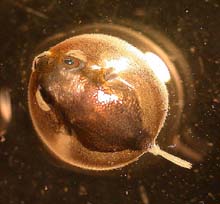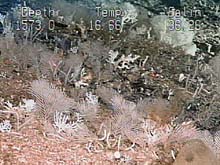
The rocky substrate is often covered with abundant invertebrates, such as coral and bryozoa. Click image for larger view.
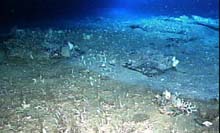
Phosphorite pavement rock is very resistant to the erosive forces of the Gulf Stream. These slabs of rock form ledges under which fish can live. Click image for larger view.
Geology of the Charleston Bump
September 28, 2001
Dr. Leslie Sautter
Dept. of Geology and Environmental Geosciences
College of Charleston
Charleston, SC
Long before technology allowed us to depict the bottom of the ocean, people thought the sea floor was a flat, featureless plain that was devoid of life. We began our inquiry of the ocean depths hundreds of years ago, when explorers first attempted to measure sea-floor depths with weighted lines cast over the sides of ships. We discovered huge mountains well below the sea surface, many of which were later found to be volcanic in origin. With the development of sonar, we began to map the sea floor. Sonar uses the speed of sound to measure sea-floor depth as a sound pulse bounces off the bottom and returns to the ship that sent it. These bottom depth measurements made it possible for us to map sea-floor topography, which is correctly referred to as bathymetry (Latin for "deep measurement"), and opened up a whole new undersea world to explore.
More recent technology has provided much greater detail of the sea floor and vastly advanced our view of ocean bathymetry. Side-scan and multibeam sonar provide incredibly detailed images, some of which can be rendered in three-dimensional depictions. With this new perspective of the deep, we have discovered that much of the sea floor is rugged and rocky, even where volcanic mountains do not exist. The Charleston Bump is such a place, with steep, rocky cliffs called scarps, deeply scoured depressions, and ramp-like rock pavement. The exploration and characterization of the habitats associated with these different types of rocky-bottom sea floor are greatly enhanced by a "fish's-eye view" from a deep-sea submersible.
On September 27, Dr. George Sedberry (chief scientist of this leg) and I dived to more than 1,600 ft aboard the Johnson Sea-Link submersible. For 2-1/2 hrs we roamed along the bottom, weaving our way through low-lying, flat rocky ledges and outcrops that were separated by broad areas of loose sand and broken coral rubble. During our descent, we had been carried off course due to the swiftness and power of the massive Gulf Stream, which sped along at more than 3.5 knots at the surface. Even though the Gulf Stream is considered to be a surface current, its effects and force extend to depths well below 1,000 ft. As a result, we rode the current during our descent and overshot our target of the Bump's primary scarp -- a drop-off that begins at a depth of 1,200 ft and extends to 1,800 ft. We tried to motor our way back toward the scarp, but the bottom current was at least 1 knot, and too strong for the sumbersible to "fight." Thus, we settled on exploring the region south of the Alfonsin Abyss. There was plenty to see!
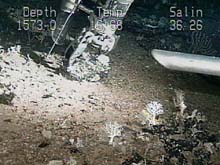
This piece of rock appeared to be loose, but was securely affixed to the underlying rock pavement, thwarting our attempt to collect it. Click image for larger view.
'Rocks, Rocks Everywhere'
The sea floor appeared to be littered with suitcase- and refrigerator-sized tabular (flat and boxy) black rocks that had numerous corals and sponges growing on them. Many of these rocks formed small, low-relief ledges. The sediments beneath the rocks have eroded away, leaving low, broad caves beneath the overhanging rock. These structures provide important protection and habitat for demersal fish. Alongside these rock outcrops, the sea floor appeared to be littered with smaller rock fragments. We made at least six attempts to collect some shoe-box-sized chunks, but every attempt failed, as these rocks were not the loose rubble they had seemed to be. Instead, they were well fastened to the rock "pavement" that underlies the thin veneer of sediments. Dr. Sedberry exclaimed, "Rocks, rocks everywhere and not a one to pick!" It was very frustrating, to say the least!
We did inadvertently recover one small, hand-sized rock during a coral collection, however. Later, when I held it in my hand, my first impression was how dense it felt. Although the rock's composition can't be determined aboard the ship, I suspect that it is a phosphorite rock, very characteristic of the Charleston Bump area. In fact, the Bump's formation is largely due to the pavement layers of this very erosion-resistant rock.
In the case of Oculina Bank, where there is concern that fishing activities have seriously damaged the Oculina coral heads, a serious need exists for a habitat map and quantitative assessments of the extent of the coral. During this mission, ROV and manned submersibles will complement each other in the quest to understand exactly how much Oculina coral remains on the bank. ROV operations will provide scientists with a relatively rapid reconnaissance and assessment of the types of bank habitats. This information will allow them to better direct the precise locations for HOV operations, where the distribution and abundance of Oculina can be studied and quantified. The scientists on this expedition are playing on the strengths of both types of technology.
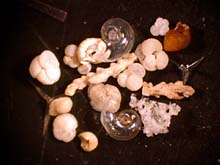
The smaller, sand-sized material includes planktonic foraminifera (the popcorn-like white tests), bryozoa stalks, pteropods (the clear, snail-like shells) and sponge spicules (the 3-pronged specimens), along with other hard remains of organisms. Click image for larger view.
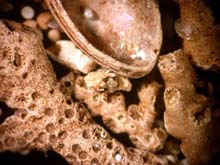
The coarse material in the sediments surrounding the rocks is comprised, for the most part, of broken coral fragments mixed with bryozoa and mollusk shells. Click image for larger view.
Rubble and Sand
Because we were so dismally unsuccessful with our rock collections, we settled on vacuuming huge volumes of the coral rubble and loose sands that existed in a 10 cm-thick layer in some places. Other areas were stripped of these sediments due to excessive current velocities. The sediments contain no fine particles (clays and silts), because the currents have already whisked them away -- a process known as winnowing. On closer inspection (i.e., once we returned to the ship's lab), we found that the coarsest fractions of the sediments were filled with fragments of a huge variety of dead coral, bryozoa, and broken mollusk shells. The smaller, sand-sized particles have no grains of rock or mineral matter, such as quartz or feldspar -- materials that would commonly make up the bulk of sand in areas closer to shore. Instead, the sand is largely comprised of smaller coral and bryozoan fragments, tiny, snail-like mollusks called pteropods, and the shells of minute organisms called foraminifera.
Foraminifera belong to the kingdom Protista; in other words, they are neither plants nor animals. They are single-celled organisms that produce a calcium carbonate (CaCO3) shell, called a test. These tests have multiple chambers, which are added as the "foram" grows. Each species has a very characteristic chamber shape and arrangement, allowing for their precise identification.
Most of the foraminifera tests recovered on our close-to-the-Bump dive are species that live in near-surface waters and are planktonic, meaning that they do not swim, but rather float at the mercy of the currents. Thus, they are not inhabitants of the deep sea, but simply drop to the bottom after they die. Nevertheless, benthic (bottom-dwelling) foraminifera exist, of which we collected several species. These organisms are adapted to live within and on top of the loose, shifting sediments. Because of the strength of the surface and the bottom currents, however, we do not know if the tests we collected represent "resident" living organisms, or those that were transported a great distance along the path of the Gulf Stream.
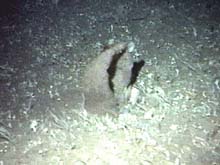
Sponges like this one, shaped like baseball mitts, face into the current. Their base is secured to the rocky substrate that lies below the loose sands. Click image for larger view.
A Rock-solid Foundation
There is no question that the currents are not only strong, but also persistent. The biota are clearly well adapted to this dynamic environment, and many rely on the rocky substrate for anchorage, protection, and a home. For example, all of the sessile invertebrate organisms (e.g., sponges, tunicates, corals) are extremely well fastened to hard, rocky surfaces. Fish and mobile invertebrates also seek refuge under rock ledges, and find prey for dinner there. Several fish we observed hovered under the rock ledges, continually swimming upstream just to maintain their position.
A few species of invertebrates have adapted to the shifting-sand environments by anchoring to the underlying pavement and growing tall enough to avoid being buried. We saw one unidentified species of large sponge (40 cm high), shaped like a baseball mitt with its cupped, concave side facing into the current, that was securely affixed to the rocky pavement beneath the sand. Presumably, this shape temporarily stops the water's flow, allowing the sponge to filter out any passing food.
The Charleston Bump is a geologic feature that, because of its abundance of rocky substrate, provides a variety of unique deep-sea habitats for many species of invertebrates and demersal fish. Without this stationary and solid foundation, organisms would be at the mercy of the Gulf Stream's impressive current, even at depths as great as 1,600 ft. Because of its rocky pavement, the Bump and surrounding rocky areas have created a true Island in the Stream.
Merry Wanderers of the Deep
September 28, 2001
Geno Olmi
Ecologist
NOAA Coastal Services Center
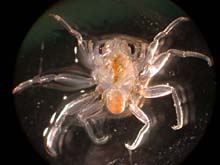
A microscopic photograph of a crab megalops from plankton collection on the Seward Johnson II. Click image for larger view.
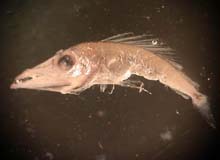
A magnified photo of a snake mackeral larvae. Click image for larger view.
It's been 10 years since Dr. Jack McGovern and I last stayed up all night collecting little critters. He was helping me on my dissertation research then, which examined the ways that the megalops stage of the blue crab returns to the Chesapeake Bay from the ocean (the megalops, or postlarval stage, falls between the larval and juvenile stages). About six yrs earlier, we had spent many a night together out in the creeks of South Island, near Georgetown, SC, where we conducted research for our masters theses at the University of Charleston. Dr. McGovern studied the larval fishes and I studied the crabs and shrimp that moved from creeks into old rice-field impoundments -- remnants of the 19th-century "glory days" of rice culture in coastal South Carolina. Memories of these past sampling trips came flooding back last night as we stood on the fantail of the Seward Johnson II, gazing out into the darkness, waiting to retrieve our nets with their bounty of plankton.
Why Plankton?
Plankton are plants and animals transported by oceanic and estuarine currents, their own swimming abilities insufficient to determine their destiny. The root of the word "plankton" comes from the Greek word planktos, which means "wandering" or "drifting." Plankton are mostly small, but some larger forms exist, including drifting seaweed and jellyfish. We categorize plankton in several ways: by size, by taxon (what is it?), and by whether the plant or animal spends all of its life in the plankton (holoplankton) or only part of its life in the plankton (meroplankton). Many invertebrate and fish species are examples of the latter -- their larval stages live up in the water, but as they grow older, they "settle out" to live near, on, or in the bottom. Although plankton are not strong swimmers, many do migrate up and down in the water, apparently in response to light intensity.
Why do we care about plankton? Plankton tells us much about the productivity of our oceans and estuaries, the relationships of plants and animals to their watery environment, and about the very young stages of the species that we must manage. As another wave washes across the stern of the Seward Johnson II, we reel in our nets, anticipating what we might learn from this sample collected 600 m above the bottom of the Charleston Bump.
A Night with the A Team
Sampling plankton from the Seward Johnson II is quite different from those nights that Dr. McGovern and I spent in the marsh creeks some 17 yrs ago. Back then, we launched a small jonboat from the bank and used an electric motor to reach our sampling station, where we lowered our nets by hand. Alligators and mosquitos were the major concerns. Last night, on the back deck of this impressive 168-ft vessel, I stood next to the Johnson Sea-Link submersible with its awesome array of cameras, lights, tanks, switches, and hoses. I worked with the ship's crew and the other four scientists and educators on the night watch (fondly referred to as the "Plankton Team" or "A Team") to coordinate the deployment and retrieval of three different sampling instruments and the data they collect.
We completed sampling at six stations during our 12-hr watch (6 pm to 6 am). At each station, we deployed a CTD rosette, which records conductivity (salinity), temperature, and depth as it is lowered to the bottom, some 550 m below. This information provides a profile of the ocean at this location. Next, we deployed a paired net array, called a bongo net, which collects plankton from just below the surface to a depth of 200 m. In these nets, we frequently collected crustaceans, such as copepods and small shrimp, and strange fish, such as snake mackerel and lanternfish. The last gear deployed at each station was a neuston net, which samples the upper half-meter of the surface waters. In addition to more lanternfish, we collected floating seaweed (Sargassum), baby sailfish and dolphin, and lots of crustaceans, including my favorites, crab megalopae.
While the submersible dives are the highlight of this voyage, I certainly enjoyed my night on the back deck sampling plankton (I don't get to do much "field work" anymore). It was a pleasure to work with the crew from the South Carolina Department of Natural Resources, and especially to work with Dr. McGovern again. Now, if I can just get some sleep before we start again tonight.
Sign up for the Ocean Explorer E-mail Update List.












































